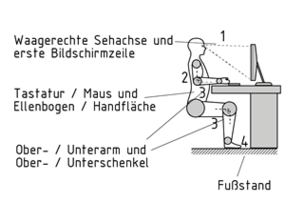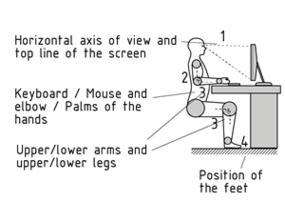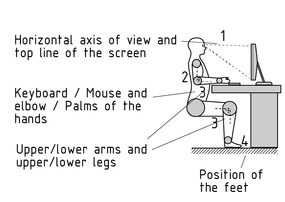
Seleccione uno
o más idiomas
0,1,3
- Alemán
- Inglés
- Chino
- Español
Estación de trabajo con computadora

Una estación de trabajo con computadora comprende una combinación de pantalla, teclado, dispositivo puntero y software. Es el acomodo de estos materiales de trabajo lo que genera una estación de trabajo con computadora optimizada.
Para asegurar que los usuarios no tengan que cambiar constantemente su enfoque visual entre las diferentes distancias ni cambiar su ángulo de visión, el teclado y la pantalla deben ser colocados tan cerca uno del otro como sea posible. La pantalla también puede ser ensombrecida, colocada adecuadamente (en un ángulo de 90° de la ventana y entre elementos de iluminación) e inclinada para evitar reflejos o deslumbramiento, lo que puede causar tensión y llevar a quejas por la postura a largo plazo. Una pantalla positiva (negro sobre blanco) permite menores rangos de contraste de manera que los ojos no tengan que adaptarse constantemente a los diferentes brillos. La luz ambiental debe ser lo suficientemente brillante y libre de parpadeos. La distancia ideal para ver depende del tamaño de la pantalla.
El contraste, el brillo y la nitidez de una pantalla (monitor) deben ser adaptados a la vista del usuario. Los parámetros clave al considerar la vista de los usuarios incluyen la agudeza visual, la profundidad de campo, la profundidad de percepción, la adaptación, el acomodo y la fijación.
Diseño de estación de trabajo con computadora óptima
1. Línea superior de la pantalla debajo del eje de visión horizontal
2. El teclado y el ratón están en el mismo nivel que los codos y las palmas de las manos.
3. El brazo y antebrazo/los muslos y las pantorrillas se doblan en un ángulo de 90°.
4. Los pies están planos sobre el piso
Bildschirmarbeitsplatz

Ein Bildschirmarbeitsplatz besteht aus einer Kombination von Bildschirm, Tastatur und Zeigegerät sowie der eingesetzten Software. Es ist die Anordnung der Arbeitsmittel, die einen optimierten Bildschirmarbeitsplatz auszeichnet.
Um ständige Entfernungssprünge und Blickrichtungswechsel der Augen zu vermeiden, werden Tastatur und Bildschirm möglichst dicht beieinander angeordnet. Reflexionen und Lichtreflexe, die zu Verspannungen und langfristig zu Haltungsschäden führen, können durch Abschattung, passende Anordnung (im 90°-Winkel zum Fenster und zwischen Beleuchtungseinrichtungen) und Neigung des Bildschirms verhindert werden. Eine Positivdarstellung (schwarz auf weiß) ermöglicht niedrigere Kontrastumfänge, sodass ständige Anpassungen der Augen an Helligkeitsunterschiede vermieden werden. Die Umgebungsbeleuchtung muss ausreichend und flimmerfrei sein. Der angemessene Sehabstand ist abhängig von der Größe des Bildschirms.
Der Bildschirm (Monitor) soll in Bezug auf Kontrast, Helligkeit und Schärfe an die Augenleistung des Benutzers angepasst werden. Besonders zu achten ist auf Sehschärfe, Schärfen- oder Wahrnehmungstiefe, Adaptions-, Akkommodations- und Fixationsvermögen der Nutzer.
1. Oberste Bildschirmzeile unterhalb der waagerechten Sehachse.
2. Tastatur und Maus liegen auf der gleichen Ebene wie Ellenbogen und Handflächen
3. Ober- und Unterarm bzw. Ober- und Unterschenkel bilden einen 90° Winkel.
4. Fester Stand der Füße
Computer workstation

A computer workstation comprises a combination of screen, keyboard, pointing device and software. It is the arrangement of these working materials that gives rise to an optimised computer workstation.
To ensure users do not constantly have to shift their visual focus between different distances and change their angle of view, the keyboard and screen should be positioned as closely as possible to each other. The screen can also be shaded, suitably positioned (at a 90° angle to the window and between Lighting elements) and tilted to prevent reflections and glare, which can cause strain and lead to postural complaints in the long term. A positive display (black on white) enables lower contrast ranges so that the eyes don't have to constantly adapt to differences in brightness. The ambient lighting must be sufficiently bright and flicker-free. The ideal viewing distance depends on the size of the screen.
The contrast, brightness and sharpness of the screen (monitor) should be adapted to the user's eyesight. Key parameters when considering the eyesight of users include visual acuity, depth of field, depth of perception, adaptation, accommodation and fixation.
1. Top line of the screen below the horizontal axis of view
2. Keyboard and mouse are on the same level as the elbows and palms of the hand
3. The upper and lower arms / upper and lower legs are bent at an angle of 90°
4. Feet are flat on the floor
计算机工作台

计算机工作台包括:屏幕、键盘、点击设备和软件。合理安排这些工作材料,从而提供一个优化的计算机工作台。
为确保用户无需在不同距离之间频繁交替视觉焦点,也不用改变其视角,因此键盘和屏幕应尽可能摆放在临近位置。也可以将屏幕适当地定位在遮蔽处(与窗口呈 90°角,处于照明元件之间),并倾斜以防止反射和眩光,否则长期使用可能导致视觉疲劳和姿势疲劳。正显(白底黑字)的对比度较低,使眼睛无需不断适应亮度差异。环境照明必须充足、无闪烁。理想的观看距离取决于屏幕的尺寸。
屏幕(显示器)的对比度、亮度和清晰度应贴合用户的视力。用户视力的主要参考参数包括视觉敏锐度、视野深度、知觉深度、适应性、调节力和注视力。
计算机工作台的优化设计
1.水平视线略高于屏幕顶行
2.键盘和鼠标在手肘和手掌的同一水平面上
3.上臂与下臂、大腿与小腿之间呈 90°弯曲
4.双脚平放在地面上
